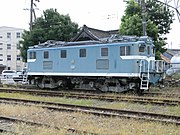Sangi Railway: Difference between revisions
Appearance
Content deleted Content added
m Japanese gauges are specified in metric units |
Aaron-Tripel (talk | contribs) No edit summary |
||
| Line 1: | Line 1: | ||
[[File:SangiRailwayCompanySangiLine.jpg|thumb|A Sangi Line 101 series train]] |
[[File:SangiRailwayCompanySangiLine.jpg|thumb|A Sangi Line 101 series train]] |
||
{{nihongo|'''Sangi Railway Co., Ltd.'''|三岐鉄道株式会社|Sangi Tetsudō}} is a private railway company in [[Mie Prefecture]], Japan. It also operates bus lines. The company was founded in 1928. Its original line, the Sangi Line, mainly functioned as a freight line transporting [[cement]], but in recent years, it also became important as a commuter railway line for [[Yokkaichi, Mie|Yokkaichi]]. The [[Sangi Railway Hokusei Line|Hokusei Line]] was transferred from [[Kintetsu]] ownership in 2003, when Kintetsu abandoned the line. Whereas the Sangi Line has a track gauge of {{RailGauge|1067}}, the Hokusei Line is one of only a few |
{{nihongo|'''Sangi Railway Co., Ltd.'''|三岐鉄道株式会社|Sangi Tetsudō}} is a private railway company in [[Mie Prefecture]], Japan. It also operates bus lines. The company was founded in 1928. Its original line, the Sangi Line, mainly functioned as a freight line transporting [[cement]], but in recent years, it also became important as a commuter railway line for [[Yokkaichi, Mie|Yokkaichi]]. The [[Sangi Railway Hokusei Line|Hokusei Line]] was transferred from [[Kintetsu]] ownership in 2003, when Kintetsu abandoned the line. Whereas the Sangi Line has a track gauge of {{RailGauge|1067}}, the Hokusei Line is one of only a few {{RailGauge|762|Alk=on}} [[Narrow gauge railway|narrow gauge]] lines in the country. |
||
==Rolling stock== |
==Rolling stock== |
||
Revision as of 10:55, 8 March 2014

Sangi Railway Co., Ltd. (三岐鉄道株式会社, Sangi Tetsudō) is a private railway company in Mie Prefecture, Japan. It also operates bus lines. The company was founded in 1928. Its original line, the Sangi Line, mainly functioned as a freight line transporting cement, but in recent years, it also became important as a commuter railway line for Yokkaichi. The Hokusei Line was transferred from Kintetsu ownership in 2003, when Kintetsu abandoned the line. Whereas the Sangi Line has a track gauge of 1067, the Hokusei Line is one of only a few 762 narrow gauge lines in the country.
Rolling stock
Sangi Line
EMUs
- 801 series - Former Seibu 701 series trains acquired in 1989
- 101 series - Former Seibu 401 series trains acquired in 1990
- 851 series - Former Seibu 701 series trains acquired in 1995
- 751 series 3-car EMUs - Former Seibu 101 series trains acquired in 2009[1]
-
801 series
Electric locomotives
- ED45 class - Since 1954 (includes former Tobu Railway locomotives)
- ED301 class - Former Nankai ED5201 class acquired in 1984
- DeKi 200 class - Former Chichibu Railway DeKi 200 class acquired in 2000
-
ED45 class ED45 1
-
DeKi 200 class Deki 203
Hokusei Line
EMUs
- 130 series - Built in 1954
- 200 series - Built in 1959
- 140 series - Built in 1960
- 270 series - Built in 1977
-
Hokusei Line 270 series train
See also
References
- ^ Tetsudō Daiya Jōhō (鉄道ダイヤ情報) March 2009 issue, p.70-71
External links
Wikimedia Commons has media related to Sangi Railway.



